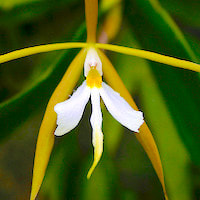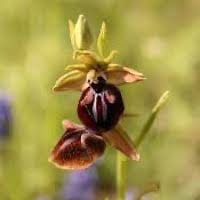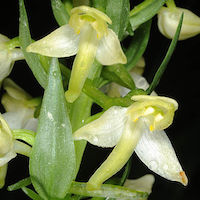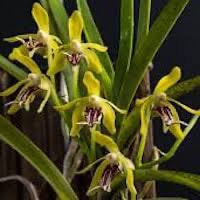Unlock the Therapeutic Power of Fresh Aromatherapy
The fragrance of the perfume contains scented notes of various proportions, including a bouquet of carnations, lily of the valley, and hyacinth, as well as hints of oakmoss and white musk.
The native Singaporean Orchid notes in the perfume come from Epidendrum Nocturnum. This orchid, though non-native, has naturalized and is cultivated in Singapore. It is native to Florida, Bahamas, West Indies, and South Florida. The scent of its flowers is particularly unique and pleasant. In the morning, it has a scent reminiscent of Vicks VapoRub, while at night, it releases a delicate cinnamon aroma.
As for therapeutic orchid notes, Ophrys sphegodes subsp. Mammosa (Desf.) Soo ex E.Nelson, also known as Ophrys mammosa Desf., is used. It blooms from early April in Cyprus and is pollinated by solitary bees called Andrena nigroaenea. The flower's scent mimics the sex pheromones of female bees to attract and deceive them, preventing cross-breeding.
Platanthera chlorantha Cust. ex Rchb., known as Eryeshechun Lan in Chinese, is another orchid used in the fragrance. It is collected from August to October in various regions of China and is commonly used in Xizang (Tibet) for its lung-nourishing properties and to treat bleeding conditions and skin infections.
Vanda cristata Wall ex Lindl., also known as Chachunwandai Lan in Chinese, is a common epiphytic orchid found in Nepal, Bhutan, northern India, Tibet, and southwest Yunnan. It is often found on the trunks of Rhododendron arboretum and Skimmia spp.
The native Singaporean Orchid notes in the perfume come from Epidendrum Nocturnum. This orchid, though non-native, has naturalized and is cultivated in Singapore. It is native to Florida, Bahamas, West Indies, and South Florida. The scent of its flowers is particularly unique and pleasant. In the morning, it has a scent reminiscent of Vicks VapoRub, while at night, it releases a delicate cinnamon aroma.
As for therapeutic orchid notes, Ophrys sphegodes subsp. Mammosa (Desf.) Soo ex E.Nelson, also known as Ophrys mammosa Desf., is used. It blooms from early April in Cyprus and is pollinated by solitary bees called Andrena nigroaenea. The flower's scent mimics the sex pheromones of female bees to attract and deceive them, preventing cross-breeding.
Platanthera chlorantha Cust. ex Rchb., known as Eryeshechun Lan in Chinese, is another orchid used in the fragrance. It is collected from August to October in various regions of China and is commonly used in Xizang (Tibet) for its lung-nourishing properties and to treat bleeding conditions and skin infections.
Vanda cristata Wall ex Lindl., also known as Chachunwandai Lan in Chinese, is a common epiphytic orchid found in Nepal, Bhutan, northern India, Tibet, and southwest Yunnan. It is often found on the trunks of Rhododendron arboretum and Skimmia spp.
Download the guided mediation that works best with this Orchid fragrance oil
| men_fresh_essential_oil_orchi_00004.mp3 | |
| File Size: | 118621 kb |
| File Type: | mp3 |
Harnessing Orchid's Healing Properties
Contains Scented Notes of following in various proportions:
`Native Singaporean Orchid notes: Epidendrum Nocturnum
|
Epidendrum Nocturnum - Used in Fresh 4 (Men) for Team building Perfume workshop
Epidendrum Nocturnum is an orchid used in the Fresh 4 (Men) perfume for team-building workshops. Although it is non-native, it has naturalized and is cultivated in Singapore. This orchid is known for its unique and pleasant scent. It is originally native to Florida, Bahamas, West Indies, and South Florida. The flowers of Epidendrum Nocturnum have an interesting reproductive behavior. They are typically autogamous, meaning they self-pollinate, and sometimes they are cleistogamous, self-pollinating before they even open. The scent of the flower has two distinct notes, which are a result of different chemical releases. In the morning, it emits a fragrance reminiscent of Vicks VapoRub, while at night, it releases a delicate cinnamon aroma. |
Therapeutic Orchid notes:
|
Ophrys sphegodes subsp. Mammosa (Desf.) Soo ex E.Nelson Syn. Ophrys mammosa Desf.
Ophrys mammosa Desf., also known as Ophrys sphegodes, is a species of orchid. It typically flowers in early April in Cyprus. This orchid species is pollinated by solitary bees, specifically Andrena nigroaenea. The bees are attracted to visual cues and volatile semiochemicals, including variable mixtures of alkanes and alkenes, particularly the latter. The flowers exhibit odor variation that mimics the sex pheromones of individual female bees. This mimicry prevents bees from revisiting the same flowers, thus affecting the success of cross-breeding. Ophrys mammosa is distributed across southeastern Europe to Iran, Iraq, and Turkmenistan. It can be found in open woodlands or light scrub areas, thriving in full sun or semi-shade conditions. The tubers of Ophrys mammosa are used for herbal purposes, particularly as Salep. |
|
Platanthera chlorantha Cust. ex Rchb.
Chinese name: Eryeshechun Lan Chinese medicinal name: Tubaiiji The herb Ophrys mammosa is typically collected from August to October, following the flowering season. It is harvested in regions of north and northeast China, including Shaanxi, Gansu, Sichuan, Yunnan, and Tibet. In traditional herbal usage, Ophrys mammosa is commonly employed in Xizang (Tibet) as a decoction to nourish the lungs and treat respiratory conditions. It is particularly used for individuals who experience symptoms such as coughing up blood, vomiting blood, or bleeding from the nose. Additionally, the plant can be ground and made into a poultice to treat lacerations, skin infections, and burns. |
|
Vanda cristata Wall ex Lindl. Syn. Trudelia cristata (Wall ex Lindl.) Senghas
Chinese name: Chachunwandai Lan Nepali name: Bhyagute phul in Nepali dialect, Vashgute phul Myanmar name: Jyo koke thitkhwa The common epiphytic orchid, belonging to the Vandaceous family, is widely distributed in Nepal, Bhutan, northern India, Tibet, and southwest Yunnan. In Bhutan and northeast India, it is commonly found growing on the trunks of Rhododendron arboretum and Skimmia spp. Phytochemical analysis has revealed the presence of a compound called laburnine acetate, a 1-hydroxymethylpyrrolizidine ester. Laburnine is a toxic alkaloid originally isolated from the unripe seeds of Laburnum anagyroides. It has shown antimicrobial activity against fungi and Shigella. In herbal usage, the plant is utilized in various ways. In India, it is made into a paste and applied to cuts and wounds. In Nepal, a paste made from the roots is used to treat boils and dislocated bones. The powdered leaves are used as an expectorant, while leaf paste is applied to cuts and wounds. In northwest India, the leaves are used to prepare tonics and expectorants. Additionally, it is used as a nutrient and tonic for general debility in Uttar Pradesh. |
Other scent note
Scentopia Library Reference ingredient
Tea - Check details at Scentopia's scent library
Join Scentopia's wonderful orchid scent crafting, fragrance tour, bridal shower or corporate team building which includes perfume making onsite and offsite, beach activities and more. We also serve primary school learning journey, secondary students and pupil on industrial excursions. Know more about our orchids perfume bar or therapeutic orchid scents and other wellness aromas. Conatct Perfume workshop or book a scent crafting session here.



